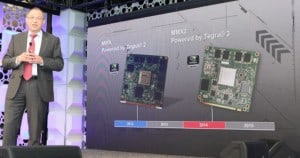Today, at the C onnected Car Expo at the LA Auto Show, Audi showed its MIB-2 (Modular Infotainment Platform) electronics architecture that shortens the development cycle for in-car infotainment systems. Audi also introduced zFAS for autopiloted autonomous drivers that is fairly small with 192-cores.
onnected Car Expo at the LA Auto Show, Audi showed its MIB-2 (Modular Infotainment Platform) electronics architecture that shortens the development cycle for in-car infotainment systems. Audi also introduced zFAS for autopiloted autonomous drivers that is fairly small with 192-cores.
MIB-2 debuts in the 2016 A6 and A7 model lines.
The new Audi MIB-2 uses the NVIDIA Tegra 30 system on chip, with a quad-core processor from the NVIDIA Tegra 3 series. When improved processors become available, the Audi MIB-2 platform will allow drivers to upgrade their software.
The processor is so fast it can handle two displays simultaneously, one in the center stack and one in the instrument cluster display. Audi and NVDIA claim that they have a two-year hardware upgrade cycle, while most other automakers take five to seven years.
 Audi and NVIDIA are also demoed a virtual cockpit with a digital dashboard that will be featured in the all-new 2016 Audi TT. The virtual cockpit replaces the instrument cluster with a central, digital 12.3-inch TFT display with 3D graphics.
Audi and NVIDIA are also demoed a virtual cockpit with a digital dashboard that will be featured in the all-new 2016 Audi TT. The virtual cockpit replaces the instrument cluster with a central, digital 12.3-inch TFT display with 3D graphics.
Audi also showed the zFAS computing module, which serves as brains of Audi piloted driving. Powered by the NVIDIA Tegra K1 mobile processor with a 192-core NVIDIA Kepler GPU, the zFAS uses the same processing architecture that powers 10 of the world’s most energy efficient supercomputers. It is about the size of a laptop computer.
We shot a video demonstration which will be uploaded in the near future.